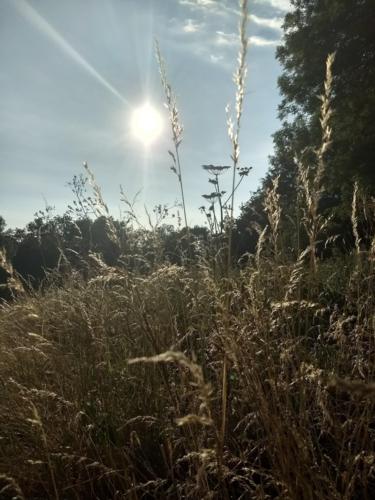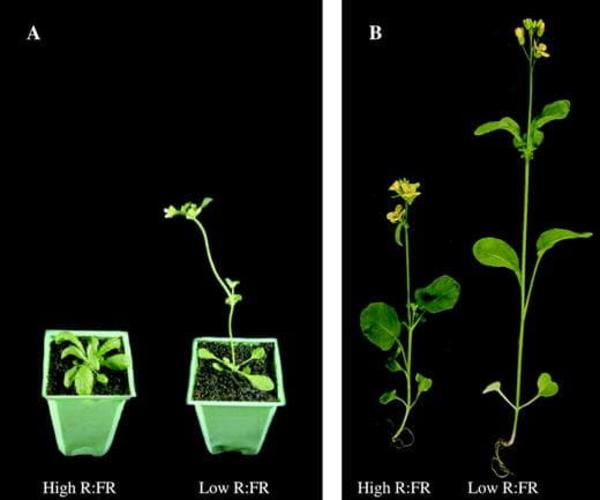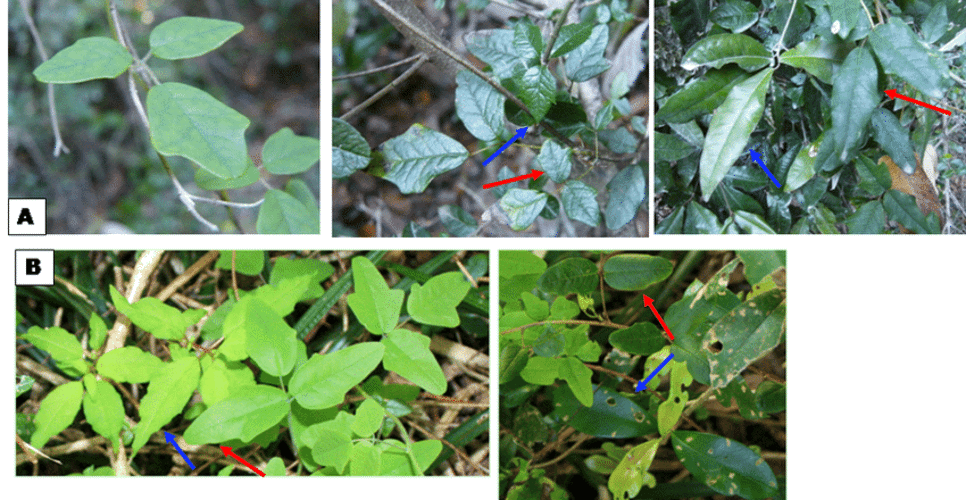August 12, 2021 by Passiflora
The Human and Inhuman Nature of Plants: Part 2 — Sight
When it comes to the senses and the analogous systems plants employ, one of the most interesting would be sight. Over time evolution has made plants into organisms extremely fine tuned to perceiving aspects about light that puts our own sense of sight to shame. Our ability to perceive light comes from opsins in photoreceptor cells. In our eyes we have cone cells and rod cells and within those cells we have opsin proteins: rhodopsin in the rod cells and photopsin in cones. Most humans have three different types of cones, short, medium, and long, so we have trichromatic vision. While our cone cells are helpful in seeing colour during the day, in the dark they’re not all too great. Our rod cells help us see in the dark while not providing much colour vision.
Humans also have cryptochrome and melanopsin. Cryptochrome activates a series of genes in response to light to control our circadian rhythm. Melanopsin is found in cells in our eyes all by itself and in very few cone cells. Melanopsin controls non-image forming light responses such as constricting our iris in bright light, and entrainment of circadian rhythm. The 3 types of cones, melanopsin, and our rod cells make up the bulk of our sense of vision with cryptochrome (and the genes it regulates) and melanopsin controlling sleep cycles and other light-dependent responses. A light independent response in our body is something done involuntarily depending on lighting conditions, for example when you walk into a bright area your irises will shrink your pupils to reduce the amount of light entering the eyes without you thinking about it. As a small aside, the name “cryptochrome” is quite the play on words. Finding this protein was quite difficult and was isolated first in plants, specifically mosses. Cryptogamic plants are plants that reproduce via spores, such as mosses. So the “crypto” in cryptochrome is quite the portmanteau and pun.
Plants have something analogous to our opsins called phytochromes and phototropins. Arabidopsis thaliana (a darling little plant that is the lab rat of the botanical sciences) has 5 phytochromes just for detecting red to far red light. On top of this, Arabidopsis thaliana also has 2 phototropins for detecting blue to ultraviolet light (specifically UV-A). Just to flex on humanity even harder, not only does Arabidopsis have cryptochrome for circadian rhythm but, unlike humans and our rather neutered cryptochrome, the cryptochrome of Arabidopsis thaliana is sensitive enough to respond to radio frequencies on top of the blue and UV-A light it detects. There’s also the zeitlupe protein, a very recently discovered light sensitive protein for entrainment of the circadian rhythm in plants. In case this already large list isn’t impressive enough, plants also have UVB8, a protein that detects UV-B light.
Plants have an impressive catalogue of light sensitive proteins that outnumber what humans possess and you may be asking yourself why something that spends the majority of its life planted in a spot would need to be so sensitive to light. Light doesn’t just serve as the source of energy for photosynthesis for plants but also carries with it vital information that plants use to maximize their odds of survival.
The feed, the fight, the fornicate.
Consider this, when you wake up in the morning it’s likely due to an alarm and you probably curse existence like I do (I’m not a morning person whatsoever). Our sleep schedules have been divorced from the day to night cycle for quite some time, though it’s become more pronounced in the modern era. Alarm clocks go back as early as ancient Greece when a fellow named Ctesibius made a system which would drop pebbles onto a gong at set intervals, but alarms could go back even further. We wake up because of how we measure time; however, plants and animals usually base their sleep cycles on light availability, or lack thereof.
So here’s a good question you may be wondering. How do plants figure out when to wake up? It may be easy to just say “when the sun rises” and you’d be partly correct but plants need to prepare for the sunrise. Those phototropins I mentioned earlier, the UV-A and blue light sensitive pigments, are how plants figure out when to wake up. They control stomata opening and closing which is how plants can breathe, migrating chloroplasts in cells, and numerous other things. During the night time, a plant may open its stomata to take up some carbon dioxide and oxygen (yes, plants need oxygen too) without losing too much water like it would during the hot day. Before a sunrise, about 20 minutes or so, the first light to come over the horizon is in the blue to ultraviolet region. The photoproteins respond to this by closing the stomata, to prevent water loss, and get the chloroplasts to migrate into position to best capture the morning light. Plants are apparently early risers. Being able to prepare for the sunrise before it happens every day is hugely advantageous for plants. Not only are they not caught off guard by the sudden shock of water loss from the rise in temperatures from sunrise but the chloroplasts being in position for the incoming light means they don’t miss out on nearly a half hour of delicious light every day.
The phytochrome I mentioned earlier is even more important in a plant’s day to day life. Because the chlorophylls of plants absorb red light quite well, but far red light quite poorly, and the level of absorption of these colours is specific to species of plants (all except for one plant species), the ratio of red to far red light provides a plant with information. Consider the following situation. Assuming a plant has 2 leaves, one near the top of the plant and the other near the bottom, if the ratio of red to far red light hitting the bottom leaf is identical to the ratio of red to far red light that passes through the top leaf that information tells the plant that the bottom leaf is directly below the top leaf. If the plant has neighbours that are closely related to it, and they’re also causing some shading, those ratios would be extremely similar too. So what is a plant to do in this situation? It “knows” that it is being shaded by either itself or a sibling. Well for Arabidopsis…
It turns its leaf away.
The leaf in question was coloured red and the dashed line shows where the leaf would have remained had the plant not used the information from the light reflected off its neighbour to tell it that it was shading kin.
This red to far red sensitivity doesn’t stop with just being kind (or hostile) to plants' kin but goes further. When a plant experiences a red to far red ratio that is different from its own, this tells the plant that it is being shaded by a stranger. In many plants this kicks off several growth changes. The leaves alter their size to capture slightly more light and it may kick off a spurt of vertical growth as the plant tries to grow up and out of its neighbours shadow. This is called shade avoidance.
Other plants go so far as to hunt by “sight”. Yes, you did read that correctly. The genus Cuscuta, commonly called dodder plants, contains plant species that parasitise other plants. They lack leaves and roots, and many lack chlorophyll too so they cannot photosynthesize for energy. Many Cuscuta find their prey following chemicals picked up in the air, but all Cuscuta hunt by sensing for the previously mentioned ratio of red to far red indicative of another plant. Once they detect it, they grow until coming in contact with a stem, wrap around it, and then grow haustorium (a root-like structure) into the stem of the other plant to start parasitising nutrients, water, and sugars. Not only are plants capable of determining if they are in shade, but also what is causing that shade.
While humans have known for quite some time that plants use light, both the quantity of light reaching them and the quality (colour spectra) of light they’re detecting — Darwin has many famous experiments on determining which portions of a plant sense light quality and quantity — the sensitivity plants exhibit is still an active area of research. Take the coffee tree, Coffee arabica. Just last year it was found that the light from a full moon causes a change in over 3,300 genes [1], and with a predicted genome of just over 70,000 genes that means that almost 1/25th of coffee’s genes change in the amount they are expressed just around midnight. This seems pretty darn extreme, but with plants these extremes frequently result in a perfectly logical explanation. Different herbivores are most active at different times of the day or night, same with pollinators. So for many plants it’s quite energy efficient to prepare any energetically and nutritionally expensive protective compounds at the peak time when they are needed rather than all the time. Plants also have internal clocks for producing nectar for pollination. In a wonderfully titled paper, “Time is honey: circadian clocks of bees and flowers and how their interactions may influence ecological communities” by Guy Block et. al [2], the authors discuss how a variety of plants alter their nectar production, pollen availability, scent producing compounds, and even their flower shape depending on when specific pollinators are most active.
Already so quickly there’s a plethora of examples showing how plants take up information from their environment just through light sources and use that information to alter their lifestyle, growth, and more. From the feeding of the dodder plants to time keeping, figuring out who their neighbours may be, and to ‘get lucky’. It may be fair to argue that the light the plants are picking up doesn’t necessarily offer the same view of the world as our eyes, as we perceive shapes. And so far, all I’ve shown is their ability to recognize colours, themselves, and the passage of time. So to end this installment of this ongoing series I would like to leave you with one last, truly remarkable plant.
Meet Boquila trifoliolata.
It may be difficult to spot in these images and for good reason — this plant is hiding. The red arrows point towards the vine and the blue arrows point towards the host plant that the vine is growing on. Boquila trifoliolata alters the shape, the angle it’s leaves hang, and its leaves’ colour to mimic the plants it grows on. If this isn’t amazing enough the vine can change these characteristics to match more than one plant as it extends from host to host. We don’t know how it does this incredible hiding, though many ideas are out there which range from stealing DNA from the host to copy leaf morphology (there’s no evidence to suggest this and there are many parasitic plants that do steal genes from hosts which cannot copy their host’s gene expression) to chalking this up to “plant sight” which would mean that this plant has some way of distinguishing shapes. While we don’t know how this vine manages such an incredible feat we have found that it results in far less herbivory on the plant. When it grows on a host that is toxic to herbivores its mimicry gives it all the benefits of the host without the cost of producing the toxins. When it grows on a host already attacked it mimics the look of the damaged leaves (to an extent) which is also beneficial as future herbivores will look for healthier plants to eat. For us humans, animals who pride ourselves on our observational skills, it should be embarrassing that this vine has been grown in botanical gardens for quite a long time and people hadn’t noticed what this vine is doing until the 2010’s. And for those who recall what I said earlier about all except one plant’s ability to absorb specific ratios of red to far red light being species-specific: this is the exception, and what an exceptional plant it is.
References
[1] Breitler, Jean-Christophe, et al. "Full moonlight-induced circadian clock entrainment in Coffea arabica." BMC plant biology 20.1 (2020): 1-11.
[2] Bloch, Guy, et al. "Time is honey: circadian clocks of bees and flowers and how their interactions may influence ecological communities." Philosophical Transactions of the Royal Society B: Biological Sciences 372.1734 (2017): 20160256.




